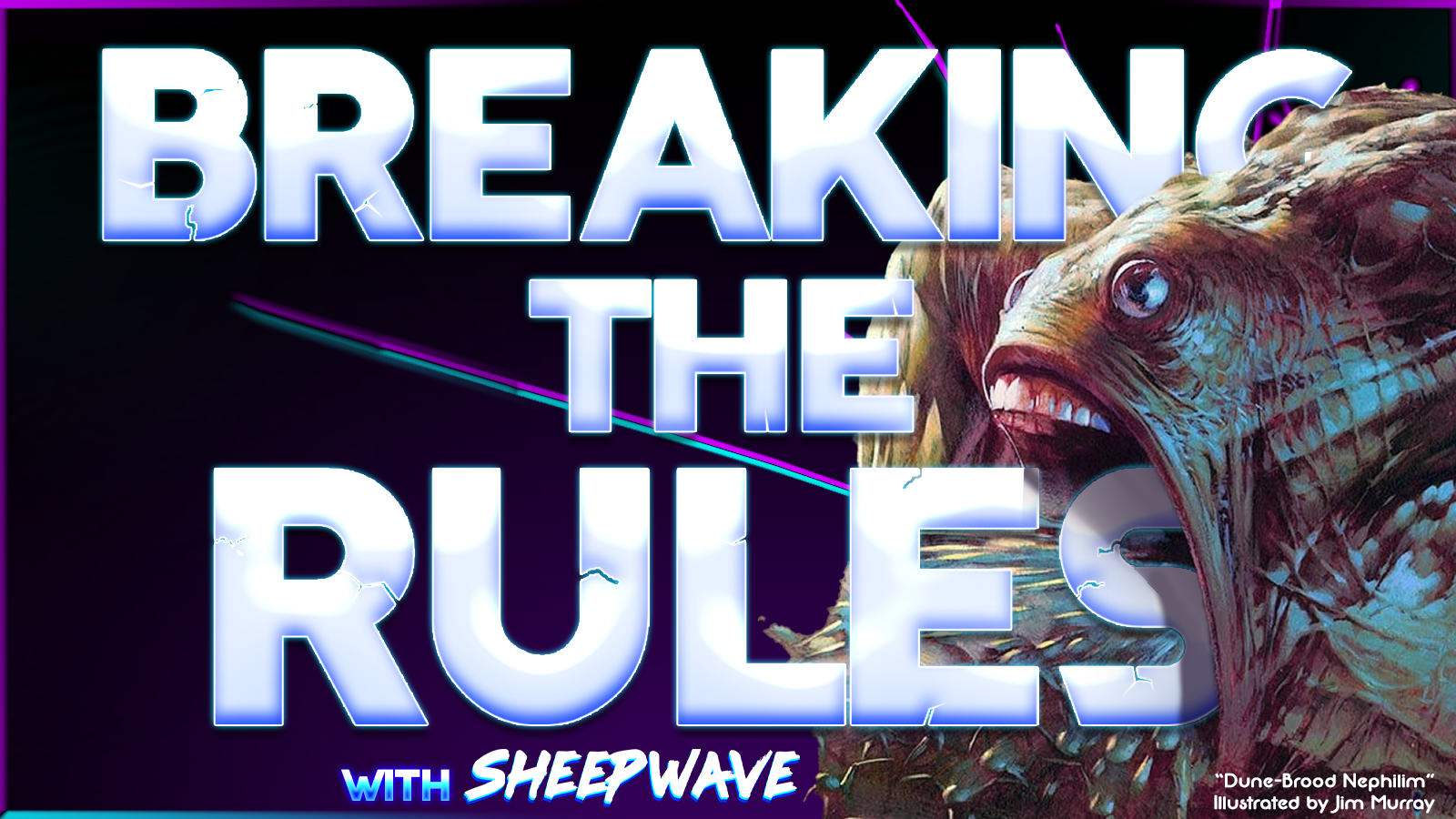Breaking the Rules: Dune-Brood Nephilim

Hello, Sheepwave here! While many of you may know me for my presence as an artist on Twitter, this article series focuses on playing EDH decks that are not legal according to the official rules, but with a bit of talking, can be played via use of the wonderful Rule Zero. In addition to discussing how one might play a "Rule Zero" deck, I will also examine both why you might do so, and how you can maximize your chances that your playgroup agrees and has a fun time. Welcome to Breaking the Rules!
Dune Brood Nephilim

Mark Rosewater has said many times that the Nephilim should have been legendary when printed, and would eratta them to be legendary if he was able to.
"In fact, in all of Magic, there is only one cycle of four-color creatures, the Nephilim from Guildpact. (And yes, with 20/20 hindsight, we should have made them legendary.)"
-"Howdy Parner", Making Magic, wizards.magic.com
I think all five of these cards are fascinating. While the color pie has shifted from under a few of them since being printed, all of them did a good job of exploring the four color using abilities that seem simple at first, but are actually quite complicated to take advantage of. I will be starting with Dune-Brood Nephilim

Dune-Brood Nephilim as Commander
The rule break for this deck is pretty simple; We simply treat Dune-Brood as though it had the supertype "legendary", and is therefore a legal four color commander. Dune-Brood Nephilim
Of all the Nephilim, Dune-Brood does the best job of pushing you in a lot of different directions with only a single triggered ability. Do you invest equipment and enchantments into the commander to make sure they can get in for damage? Do you use anthem effects to buff your sand token army? Do you try to get as many lands into play as possible to maximize the payoff from the trigger? Do you sacrifice the tokens for value, or do you attack with them? Do you desperately try to make sand tribal happen?

My favorite thing about this commander is that all the strategies I just listed are viable and fun ways to play it. My build of the deck is generalized, dabbling in all of these, meaning it never feels stale and the direction it goes depends a ton on what you draw.
Spicy Includes
Go Tall, Beat Face
So Dune-Brood wants to get in for combat damage to a player. Unfortunately, lacking any form of innate evasion combined with an ability that produces obscene amounts of value when it goes off means we need to invest into augmenting our commander using enchantments and equipment.
Only one thing is better than getting a combat damage trigger; Getting a combat damage trigger twice. Fireshrieker
You're going to be amazed how many times people try to kill your commander.Apostle's Blessing
It's coarse and rough and irritating and it gets everywhere
Congrats, you've successfully gotten Dune-Brood through for damage once or twice and now are sitting on a double digits pile of 1/1 sand tokens. Now what?
is Tromp the Domains
But let's not get too attached to actually keeping those tokens around. Skullclamp
Multicolor Jank Soup
one of the problems with 4 and 5 color decks, especially when they have perfect mana thanks to fetches and duals, is that they often devolve into goodstuff soup. It is very easy for them to simply run the best individual cards in every color they have access to with little downside.
However, I prefer to do the opposite. There are so many good cards that I almost never actually play because they're 2 or 3 color and are never quite exactly what the decks I have that match that color identity are looking for.
I absolutely love multicolor split cards. While most players are well aware that cards that grant choices are always more powerful than they first appear, the way that color identity works is often not kind to them.
Sometimes People Say "No"
...Not very often though. For a very long time, the only way to play a 4 color EDH deck at all was to use a Nephilim as your commander. In addition, the Nephilim are all-- With one inky exception-- Far less game warping than thier 4c Commander 2016 or counterparts are. But if someone really doesn't like using a technical nonlegendary as a commander, Tana, the Bloodsower
Final Thoughts
I've had a special place in my heart for these weird and underpowered four color creatures since I got one in the very first pack of Dissension I opened. I love how they open up into so many directions with so little text. Omnath, Locus of Creation
In this deck, I decided to touch on every strategy the commander works with, rather than focusing on just making an aristocrats deck, or a lands deck, or a voltron deck. It's extremely open ended, and I encourage everyone to take a shot at building thier favorite Nephilim! I should note that while this is not a budget deck at all, pretty much the entire cost is tied up in lands. A budget version will probably play a turn or two slower but is still quite viable.
Commander (1)
Creatures (12)
Artifacts (12)
Sorceries (15)
Instants (14)
Lands (39)
- 1 Arid Mesa
- 1 Ash Barrens
- 1 Blood Crypt
- 1 Bloodstained Mire
- 1 Command Tower
- 1 Exotic Orchard
- 1 Fabled Passage
- 4 Forest
- 1 Godless Shrine
- 1 Haunted Ridge
- 1 Marsh Flats
- 1 Misty Rainforest
- 3 Mountain
- 1 Overgrown Farmland
- 1 Overgrown Tomb
- 3 Plains
- 1 Polluted Delta
- 1 Prismatic Vista
- 1 Reflecting Pool
- 1 Sacred Foundry
- 1 Spire Garden
- 1 Stomping Ground
- 3 Swamp
- 1 Rockfall Vale
- 1 Temple Garden
- 1 Undergrowth Stadium
- 1 Verdant Catacombs
- 1 Windswept Heath
- 1 Wooded Foothills
- 1 Yavimaya, Cradle of Growth